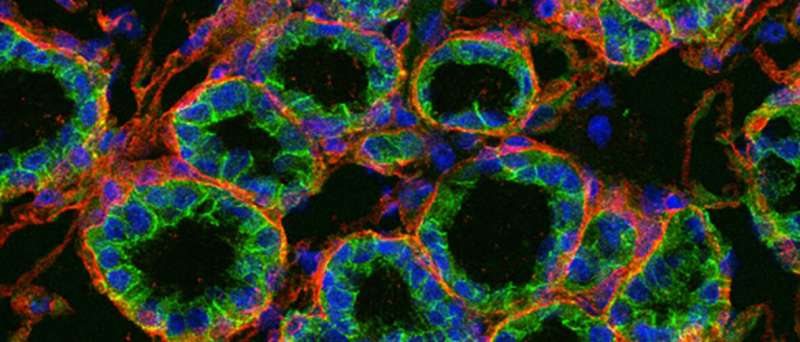Microscopy image of mammary epithelium of a pregnant mouse, which has Lama5 gene deleted from the luminal epithelial cells (green: epithelial cell junctions, red: laminin, blue: nuclei). Credit: Johanna Englund
Scientists at the University of Helsinki have found an essential factor from the extracellular matrix that regulates the functionality of breast tissue.
Extracellular matrix (ECM) has previously been recognized as an important element for the growth of various epithelial cells, as a scaffold. A new study shows that ECM can also regulate the function of epithelial cells.
Our tissues contain differentiated cell types, which perform specific tasks that are tightly controlled. Normal growth and functioning of tissues is possible only when the various differentiated cell types interact appropriately. Differentiation and function of breast epithelium is guided by a group of cells responsive to estrogen and progesterone hormones. In the recent study it was found that these cells produce an ECM protein in their surroundings, and this regulates the growth and differentiation of the epithelium from outside the cells. The production of this protein, Lama5, was found to strengthen the functionality of these cells.
Hormone responsive cells can sense growth signals, such as cues from hormones and growth factors, and relay them into neighboring cells. When the Lama5 gene was deleted from these cells, they became unable to relay these signals and halted the growth of the entire epithelium.
"This study shows that the extracellular environment produced by the cells themselves is an important factor for the identity and function of epithelial cells, and therefore for the whole tissue," says assistant professor Pekka Katajisto from University of Helsinki. The study was conducted in his laboratory.
Development during pregnancy and milk production is impaired
Hormone responsive cells were previously not known to participate in generating the surrounding ECM or even have ECM contacts.
"We observed that surprisingly, the hormone sensing cells were producing Lama5, which is critical for the proper function of these cells. Without expression of Lama5 gene, the hormone sensing cells will lose their identity, and can't support growth of the epithelium for instance during pregnancy", says Doctor Johanna Englund, the main author of the study.
The study was conducted using an organoid culture of isolated epithelial cells from mouse mammary glands. The organoids can in specific conditions be induced to produce milk.
"Our results suggest that lack of ECM factor Lama5 impairs also milk production," Englund says.
Results from this study can help to understand how breast cancer is initiated. 70-80% of breast cancers arise from the hormone sensing cells, and it is conceivable that these cancer cells are also dependent on Lama5 for their growth.
More information: Johanna I. Englund et al, Laminin alpha 5 regulates mammary gland remodeling through luminal cell differentiation and Wnt4-mediated epithelial crosstalk, Development (2021). DOI: 10.1242/dev.199281
Journal information: Development
Provided by University of Helsinki
























